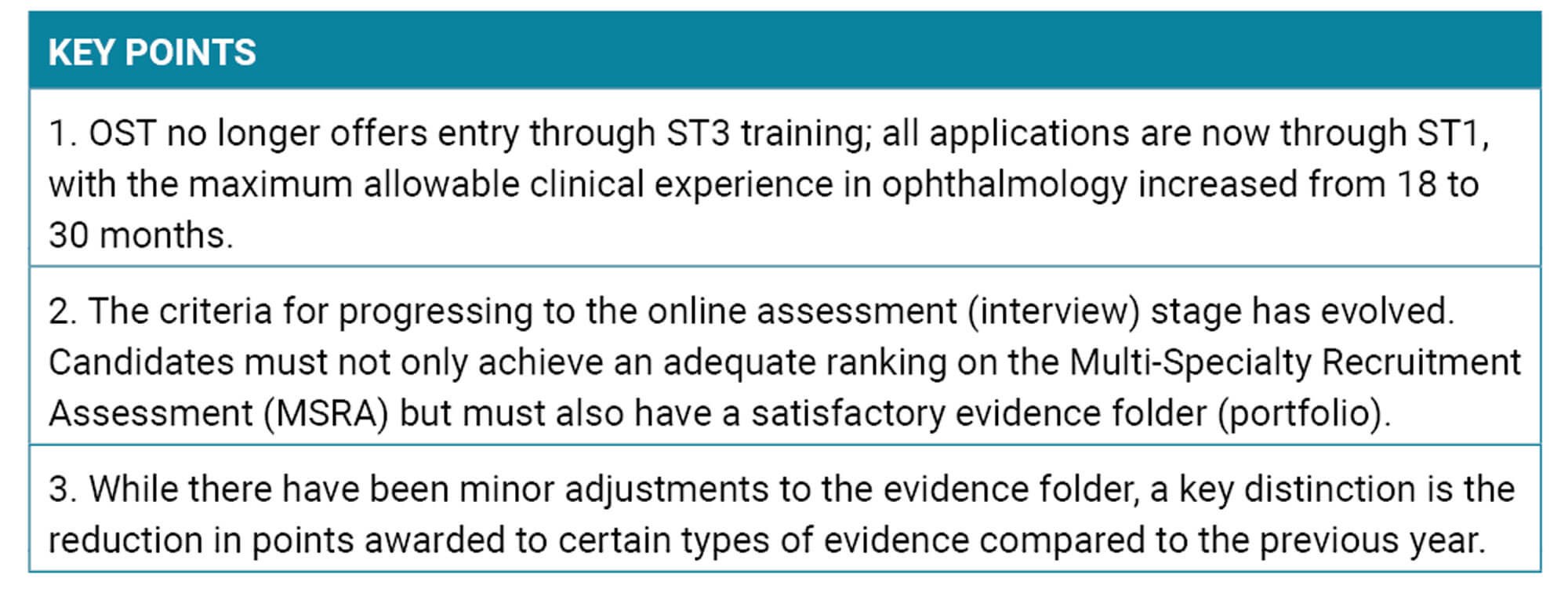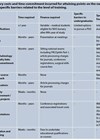
The 2024 intake for ophthalmology specialty training (OST) has undergone several significant changes in its approach towards candidate selection and assessment. This article provides a comparative analysis, detailing these new measures and comparing them against the previous year's standards. Our aim is to offer clarity and guidance to potential candidates, helping them navigate the updated system.

Curriculum 2024
The new curriculum is being introduced for the 2024–2025 training year. The development of the new curriculum was in response to the general medical council’s (GMC) generic professional capabilities framework which describes the capabilities required from every doctor.
The Royal College of Ophthalmologists (RCOphth) has developed the curriculum to align with this framework and to meet the changing needs of service demand and evolving training requirements. One key consideration in the curriculum was to enable trainees to develop competencies to take up UK consultant posts after completion of training.
Eligibility to apply
Previously, candidates had the option of entering through either ST1 or ST3. With the new OST curriculum introduced for 2024 entry, the ST3 pathway has been removed. The maximum allowable clinical experience in ophthalmology for ST1 entry has been increased from 18 months to 30 months.
The 2024 intake has refined the criteria for advancing to the online assessment stage. For this year, the top 300 scorers on the MSRA will advance to the next phase. These candidates are then required to upload their portfolios. Only those with a portfolio score of 40% or above will be eligible for the online assessment.

The MSRA is a computer-based assessment which aims to assess essential competencies in the person specification with clinical scenarios. There are two papers: professional dilemmas and clinical problem solving.
Online assessment details
Previously, the online assessment consisted of only one station, however, this year it will feature two distinct interviews, each centred around a medical consultation. Candidates will engage in conversations with actors portraying patients or their care providers. One interview will focus on clinical knowledge, while the other will tackle a challenging communication or ethical scenario. Two assessors will observe these interactions, evaluating candidates based on predefined criteria. To progress to the offer stage, candidates must achieve at least 40% of the available marks.
Evidence folder
The evidence folder is 50% of the total score and remains a crucial component of the application, offering candidates an opportunity to showcase their achievements. This year’s guidance provides a more detailed breakdown, elucidating specific criteria for acquiring points. This approach introduces more stringent marking but simultaneously provides greater clarity for candidates on how to secure those points. There is a noticeable shift in the allocation of points for certain types of evidence. Domains such as commitment to ophthalmology, prizes / awards, and teaching / education now award fewer points for the same evidence as last year.
How best to plan the portfolio
Getting into OST is a competitive process, requiring a commitment and being proactive throughout medical school and junior doctor training.
There is a variety of achievements required, which is a good reflection of what is expected of trainees during specialty training. This is also a good opportunity to gain experience from these achievements and get a sense of what ophthalmology training is like.
"The 2024 intake has refined the criteria for advancing to the online assessment stage"
Be initiative-taking in undergraduate – there are a selection of points only available to undergraduates such as the Duke Elder exam or undergraduate ophthalmology-based electives.Get involved in teaching projects at your local medical school or hospital.
Form links with the ophthalmology department – you can undertake taster weeks, clinic / theatre sessions as well as contribute to audits, quality improvement projects and research.
Attend conferences and try to present your work at these meetings. Try to aim for international meetings as these give maximum points.
Conclusion
With the rollout of the new OST curriculum, entry is now exclusively through ST1, accommodating a broader spectrum of clinical experience. Candidates will need to meet the threshold for the MSRA score and present a robust portfolio to secure an interview. Due to the updated and more detailed criteria for the evidence folder, candidates are advised to review their submissions with care, as points from the previous year may not carry over or may be valued differently.
Recommended reading
1. Applicant Guide: Ophthalmology (2023). Severn Postgraduate Medical Education.
https://www.severndeanery.nhs.uk/
recruitment/vacancies/show/oph-st1-24/
applicant-guide-lib
2. Curriculum 2024 (2023). The Royal College of Ophthalmologists.
https://www.rcophth.ac.uk/training/
ophthalmic-specialist-training/
ost-curriculum/curriculum-2024
3. What’s in the MSRA (2023). Health Education England Medical Hub.
https://medical.hee.nhs.uk/medical-training-recruitment/
medical-specialty-training/multi-specialty-recruitment
-assessment-msra/whats-in-the-msra/structure-of-the-msra
[All links last accessed November 2023]
COMMENTS ARE WELCOME








